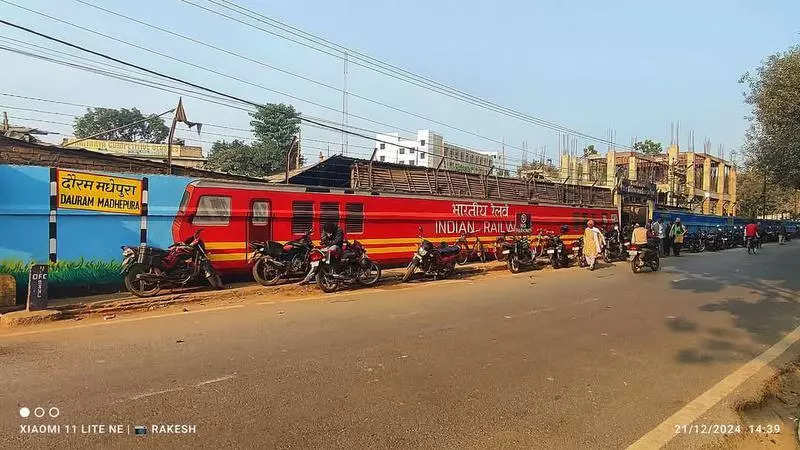Wall art revives memories of iconic passenger train | Patna News – Times of India

Madhepura: The roadside boundary wall of the district registration office here, recently painted with train bogies, has sparked nostalgic memories of the erstwhile “Ghat Gari” — the 409/410 passenger train that once connected Katihar to Mahadeopur Ghat in the 1970s. This iconic train was a lifeline for the flood-prone region, ferrying passengers to other parts of the state and beyond, despite its numerous quirks and challenges.
Nicknamed “Ghat Gari” for its notorious sluggishness, the train was often cancelled due to delays or technical snags in its meter-gauge steam engine. Its distinctive features included missing window screens, fans and light bulbs, which became symbolic of its charm. “It was the only long-route train in the area, crossing stations like Madhepura, Saharsa, Mansi, Thana Bihpur and Mahadeopur Ghat, where passengers were ferried onward by steamers to Bhagalpur,” said Chote Lal Mandal, a resident of Bhan village.
Broad-gauge tracks were a distant dream then and people accepted the train’s delays as a part of life. “The train’s pace shaped the region’s mindset,” said senior citizen Narayan Prasad. “Being late became second nature. Even today, construction of NH-106 and NH-107 has dragged on for over a decade in a reminder of this culture of delay,” he added.
Travelling on the Ghat Gari was a unique experience. Tickets were often ignored by commuters between Dhamhara Ghat and Saharsa with many passengers simply pulling the train’s chain to alight at their chosen destinations. The train carried not only passengers but also bicycles, milk containers, vegetables and bundles of grass. However, it was also infamous for its gamblers, pickpockets and bag snatchers.
A distinctive feature of the train was the “khoya peda” vendors who roamed its bogies. Passengers often bought sweets to avoid the wrath of these aggressive sellers, who terrorised those unable to purchase their goods. “Even train staff avoided conflicts with them,” Mandal said. “Station officials maintained a reluctant relationship with these vendors as they depended on them for survival,” he added.
Mandal also narrated anecdotes passed down by his father. In one instance, an elderly woman passenger at Mithai station asked a man fetching his relatives for water. When the man revealed his caste, she began hurling abuses, showcasing the deep-seated prejudices of that era. On another occasion, Mandal’s father waited the entire day at Mithai station for a relative expected to arrive by the train, only to be informed late in the evening that it had been cancelled due to engine failure.
Nicknamed “Ghat Gari” for its notorious sluggishness, the train was often cancelled due to delays or technical snags in its meter-gauge steam engine. Its distinctive features included missing window screens, fans and light bulbs, which became symbolic of its charm. “It was the only long-route train in the area, crossing stations like Madhepura, Saharsa, Mansi, Thana Bihpur and Mahadeopur Ghat, where passengers were ferried onward by steamers to Bhagalpur,” said Chote Lal Mandal, a resident of Bhan village.
Broad-gauge tracks were a distant dream then and people accepted the train’s delays as a part of life. “The train’s pace shaped the region’s mindset,” said senior citizen Narayan Prasad. “Being late became second nature. Even today, construction of NH-106 and NH-107 has dragged on for over a decade in a reminder of this culture of delay,” he added.
Travelling on the Ghat Gari was a unique experience. Tickets were often ignored by commuters between Dhamhara Ghat and Saharsa with many passengers simply pulling the train’s chain to alight at their chosen destinations. The train carried not only passengers but also bicycles, milk containers, vegetables and bundles of grass. However, it was also infamous for its gamblers, pickpockets and bag snatchers.
A distinctive feature of the train was the “khoya peda” vendors who roamed its bogies. Passengers often bought sweets to avoid the wrath of these aggressive sellers, who terrorised those unable to purchase their goods. “Even train staff avoided conflicts with them,” Mandal said. “Station officials maintained a reluctant relationship with these vendors as they depended on them for survival,” he added.
Mandal also narrated anecdotes passed down by his father. In one instance, an elderly woman passenger at Mithai station asked a man fetching his relatives for water. When the man revealed his caste, she began hurling abuses, showcasing the deep-seated prejudices of that era. On another occasion, Mandal’s father waited the entire day at Mithai station for a relative expected to arrive by the train, only to be informed late in the evening that it had been cancelled due to engine failure.
















